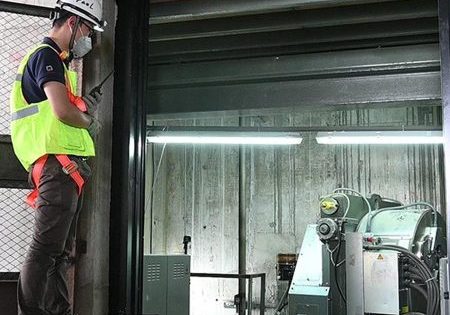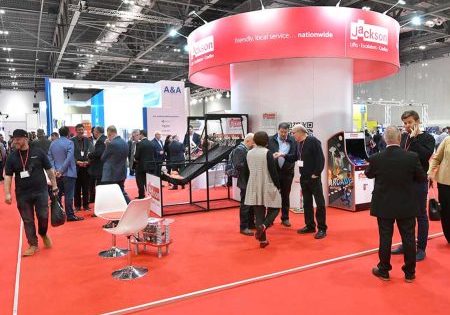In this series conclusion, the Great Britain lift system of 1860-1869 is compared with that of the U.S.
The period between 1860 and 1869 witnessed the gradual expansion of passenger lift use in Great Britain as architects, engineers, building owners and the general public became aware of the potential of vertical transportation systems. The pattern of early British lift usage closely paralleled that found in the U.S. in that their primary application was in large urban hotels. Part one of this two-part article focused on the lifts employed in the Westminster Palace Hotel (1861) and the Grosvenor Hotel (1862). These buildings inspired the construction of other large hotels built across Britain. Each hotel employed multiple lifts for hotel services, luggage, and passengers; and these new mechanical amenities were often highlighted in articles published in engineering and architectural journals, as well as newspapers. While the former served to educate the professional community, the latter introduced the public to this new technology.
When the London Bridge Railway Terminus Hotel, designed by Henry Currey (1820-1900), opened in January 1863, the London Evening Standard reported on the building’s size and the necessity of providing lifts:
“From basement to attic, it is no less than ten stories high, an elevation which fully requires the assistance of the hydraulic lift that is now being fitted for the conveyance of customers and baggage from floor to floor, in addition to the numerous smaller ones by which dinners, etc., are conveyed to their respective destinations.”[1]
This account is typical in a somewhat surprising way — it was not uncommon for hotels to open while work on the passenger lifts was incomplete. This may reflect the simple fact that, because older hotels did not feature lifts, guests were accustomed to climbing stairs, and the habit of using a lift had not yet been established. The lift was also perceived as one of a host of new technological amenities people increasingly expected to find in a modern hotel. This sentiment was expressed in the December 1863 announcement of the proposed Clarence Hotel in Dover: “All the modern necessities of joint-stock hotels are provided in the shape of hydraulic lifts for food, luggage and passengers, the newest appliances of bells and speaking-tubes, and apparatus for cooking, heating, washing, etc.”[2]
The hotel that elevated the lift to a position of preeminence among its rival amenities was the Grand Hotel in Brighton, which completed in 1864. In November 1863, the Building News reported on the hotel’s lifts, which were under construction:
“One of the most extraordinary pieces of ingenuity in the building is the ‘lift,’ or rather ‘lifts,’ for visitors and luggage … These are being executed by the firm of Easton and Amos, of Southwark. Should a visitor to the hotel wish to proceed up to the second, third or fourth floor, instead of going up by the ordinary grand staircase, he can give the signal to the man in charge of the apparatus, step into a comfortable little lobby, the bell will ring, and the motion of the machinery will be so smooth, that he will scarcely know he is ascending. The ‘lifts’ are to be worked by hydraulic power, embracing all the modern improvements.”[3]
Information on the Brighton Hotel lifts was probably provided by John Whichcord, the building’s architect.
These buildings inspired the construction of other large hotels built across Britain.
Whichcord (1823-1885) was one of the first British architects to recognize the lift’s potential to transform architecture. He articulated this potential in a paper presented at the General Meeting of the Royal Institute of British Architects (RIBA) on January 18, 1864. His paper, titled “On Hydraulic Lifts,” provided an overview of this emerging technology and included a detailed account of the direct-acting lifts built by Easton & Amos for the Brighton Hotel.[4] Although Whichcord’s paper was not published by the RIBA until the fall of 1864, his presentation immediately attracted the attention of the popular press. The May 21, 1864, issue of Chamber’s Journal included an article titled “The Upstairs Omnibus,” which characterized the Brighton lifts as the harbinger of significant change. After a broad (and somewhat rambling) history of lifts, the article’s unknown author claimed:
“But it seems as if we are on the eve of something different in regard to the working of these up-and-down rooms or platforms. We now talk of hydraulic lifts; and we promise to convert the rooms into such nicely fitted and seated, and cushioned and carpeted saloons, as to resemble first-class railway carriages, or, at any rate, the better kind of omnibus. Hence the designation upstairs omnibus.”[5]
The article also included a general description of hydraulic lift operation and of the lift system designed for the hotel. The latter description addressed the different types of lifts employed, beginning with the passenger lift:
“At the new Brighton hotel, we are told, the principal of the five hydraulic lifts works up and down in a vertical shaft eight feet square … The little movable saloon within it will accommodate seven or eight persons at once, who can be raised to the uppermost of five stories in one minute, or to any of the intermediate stories in few seconds less time … This is par excellence, the visitors’ lift, not to be used by mortals of less exalted dignity. A second lift ascends from the basement to the fifth story, intersecting and communicating with all the intermediate stories in its way; the ascent is seventy-six feet, and the purpose, we believe, is to facilitate the ascent of servants with their burdens. A third lift, about as lofty as the second, is for sending up dinners from the basement to the grand coffee-room only and not hundredweights of humanity. A fifth carries up wines and other liquors from the cellar to the bar.”[5]
Edited versions of the Chamber’s Journal article appeared in numerous British newspapers, all of which highlighted the “little movable saloon,” or passenger lift.
The Langham Hotel (Portland Place, London), designed by John Giles (1831-1900) and completed in 1865, also featured direct acting hydraulic lifts manufactured by Easton & Amos. The passenger lift car was described as a “handsomely fitted” room and as an “elegant chamber.”[6, 7] One contemporary account described the imagined impact of the passenger lift on daily life in the Langham and also critiqued the character of its riders:
“The staircases, broad as they are, will be almost deserted and their landings lonely; for everything will be done in the ups and downs of the Royal Langham by lifts. There is a passenger lift for the large and lazy, the feeble and fatigued; and there are luggage lifts, dinner and breakfast lifts, and coal lifts, each and all worked by hydraulic pressure.”[8]
Although the hotel opened in mid-July, work on the lifts continued throughout the summer, and by mid-August, Easton & Amos was engaged in training hotel personnel in lift operation. It was during this transition period that a fatal accident occurred.[9, 10]
Although the hotel opened in mid-July, work on the lifts continued throughout the summer, and by mid-August Easton & Amos was engaged in training hotel personnel in lift operation. It was during this transition period that a fatal accident occurred.
The coal lift was designed to be operated from within the car by a shipper rope and the lift was parked in the basement when not in use. If a member of the hotel staff was on an upper floor and needed the lift, they had to walk down to the basement to access the lift car. On September 1, 1865, William R. Chasmer, one of two men being trained on the lift’s operation, was on the hotel’s mezzanine level when he realized that he needed the lift. Instead of walking down to the basement, Chasmer climbed onto a metal railing that protected the lift shaft, leaned into the shaft and pulled the shipper rope. He had intended to stop the car when it reached the mezzanine; however, he misjudged the car’s movement and the top of car struck him below his chin and he was carried upward and became caught between top of the lift and the ceiling. He suffocated before someone could be found to reverse the lift’s action. The inquest found that Easton & Amos had not officially given control of the lifts to the hotel and that Chasmer had not followed proper protocol, thus the tragic event was ruled an “accidental death.” This event serves as a reminder of the many dangers associated with early lift systems and a reminder that many accidents were often the result of human error, rather than technological failure.
The accident in the Langham was one of only two that occurred in hotels between 1860 and 1869. The other accident (discussed in Part One of this article, EW July 2022), also occurred in 1865 and involved a passenger lift in the Grosvenor Hotel. Following this accident, in which two passengers were killed and several others injured, the hotel management assured the public that “the best skill which could be obtained in the refitting of the lift would be employed, and that any other accident should be impossible.”[11] An 1869 account of the “refitted” lift in the Grosvenor reveals that Easton & Amos replaced their original geared hydraulic lift with a direct acting lift similar to those employed in the Brighton and Langham Hotels. This account, simply titled “Lifts” and published in The Architect, also provides a fitting conclusion to this examination of the first decade of British lifts as it effectively captures the sense of wonder associated with these early machines.
There is a passenger lift for the large and lazy, the feeble and fatigued; and there are luggage lifts, dinner and breakfast lifts, and coal lifts, each and all worked by hydraulic pressure.
The article’s unknown author recounted that he was given a personal tour of the Grosvenor lifts by Edward Easton, one of the founders of Easton & Amos (which had become Easton, Amos & Anderson by 1869):
“We went in the evening, and will briefly describe what we saw. Mr. E. took us at once to the lift, which by his orders immediately descended to the basement; all was darkness, but a small jet of gas lighted at some distance threw a dim, if not religious, light upon the lift; he then ordered the lift up to show its action, and it slowly rose; as it rose it was apparently supported in the center below by an iron column, but it rose and rose through floor after floor, and looking up the immense height of the shaft, 90 feet, floor after floor, the gaslight from the openings to the staircase showed the increasing height, until it reached the summit; the effect was almost magical; the noiseless, ceaseless rise of the apparently endless column, an iron tube as thick as a ship’s mast, as tall as an ordinary church steeple, and as true as a gun-barrel.”[12]
The lift that provided this magical experience was used by hotel staff to transport luggage and service items:
“The car or lift room is, in this case, 8 feet square in the clear, and 7 feet 6 inches high; and as it is used for all descriptions of luggage and household work, no particular care is displayed in its fitting-up. It is a plain box with wrought iron frame lightly constructed of and T and L iron, and cased with boarding. In some others of similar character, the room fitted up with seats, gilding, and crimson velvet; but this is a mere matter of upholsterer’s detail. The guides are T iron, and the cage fitted with the ordinary cast iron rollers; but Mr. Easton recommends V-shaped carefully planed guides, with the corresponding angles fitted on the cage, a sponge full of oil being fixed on the top end, so that by their own action the guides are kept perfectly oiled.”[12]
The tour concluded with the author given an opportunity to drive the lift. Their description of the experience is a rare firsthand account of lift operation in the 1860s:
“(A)s to … (the) method of working, it is evident that no ordinary valve without special adaptation could control this enormous head of water and be worked by hand. A lever of some length is therefore introduced, which is under the control of a rope which passes through the center of the cage or lift room, with which up and down a servant always travels who has the control of it; and such delicacy of action has been attained by practice that the point of stopping can be attained to an inch without the slightest jar or jerk. Indeed, the actual exertion of physical strength required to control this motion, we can say from personal experience, is just about equal to that required in riding a light-mouthed thoroughbred horse. We were told to try and stop the lift; we thoughtlessly grasped the rope, and found to our surprise that we brought the thing up with a sudden jar, and a kind of clack like that of a tap suddenly turned off was manifest. We should have done our spiriting far more gently, and arrested its progress by a tender pressure of the finger and thumb.”
The extraordinary account of the visit to the Grosvenor lifts presents clear evidence that it took only 10 years for the lift to insinuate itself into British popular culture such that it was perceived as one of the most dramatic — and magical — transportation systems yet developed.
References
[1] “Metropolitan Improvements: VIII – Hotels,” London Evening Standard, (January 28, 1863).
[2] “The Clarence Hotel, Dover” The Dover Telegraph (December 12, 1863).
[3] “New Hotel, Brighton,” The Building News (November 20, 1863).
[4] Lee Gray, “On Hydraulic Lifts (1864),” EW (July 2017).
[5] “The Upstairs Omnibus,” Chamber’s Journal of Popular Literature, Science, and Arts (May 21, 1864).
[6] “The Langham Hotel,” London Morning Post (April 13, 1865).
[7] “The Langham Hotel,” The Railway News (April 15, 1865).
[8] “The Langham Hotel,” Bell’s Weekly Messenger (June 17, 1865).
[9] “A Man Killed by a Hotel Lift,” Usk Observer and Monmouthshire Central Advertiser, September 16, 1865.
[10] “Fatal Accident by a Hydraulic Lift,” London Morning Post, September 5, 1865.
[11] “Summary of This Morning’s News,” Pall Mall Gazette (June 20, 1865).
[12] “Lifts,” The Architect (October 9, 1869).
Get more of Elevator World. Sign up for our free e-newsletter.










